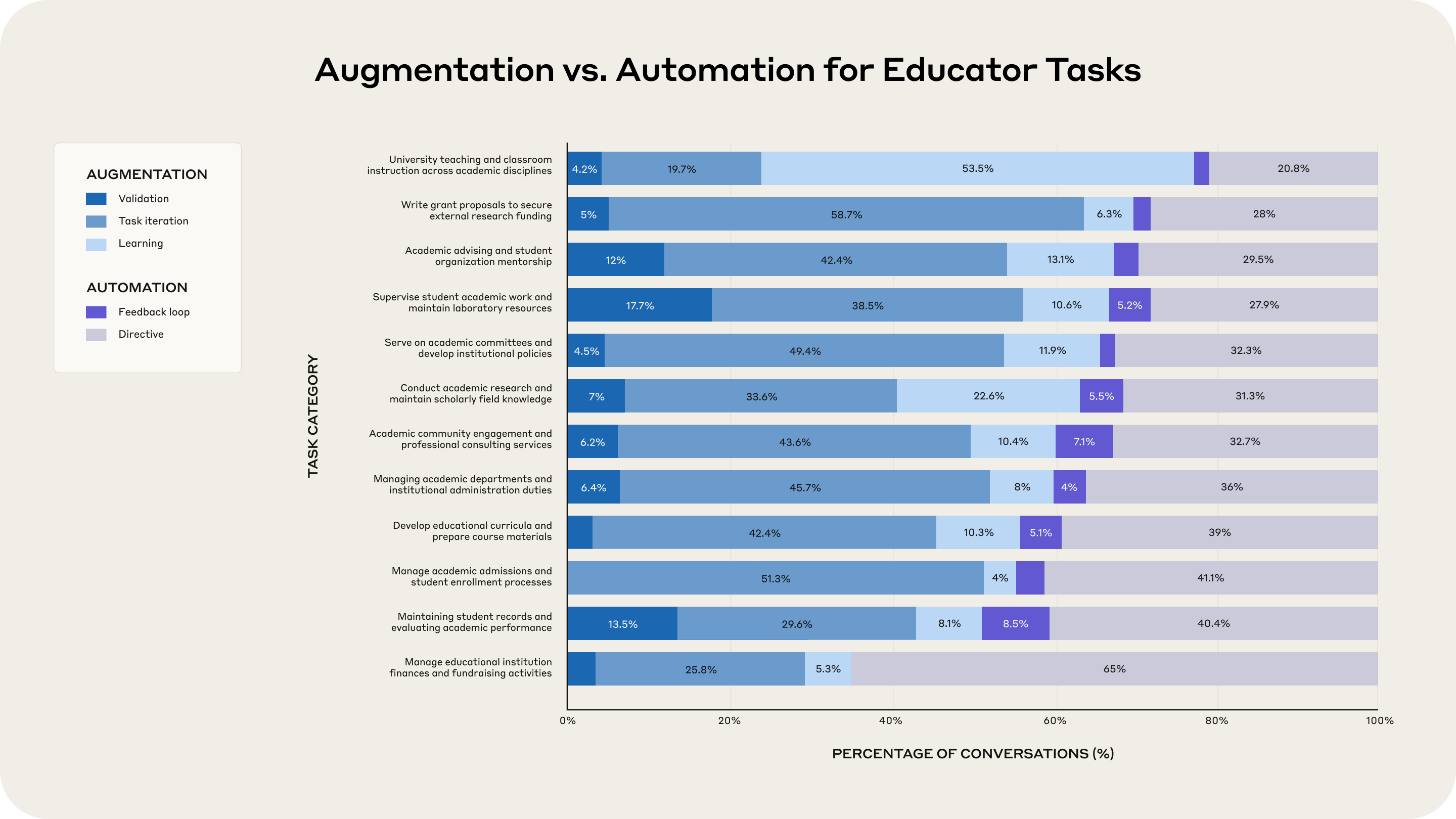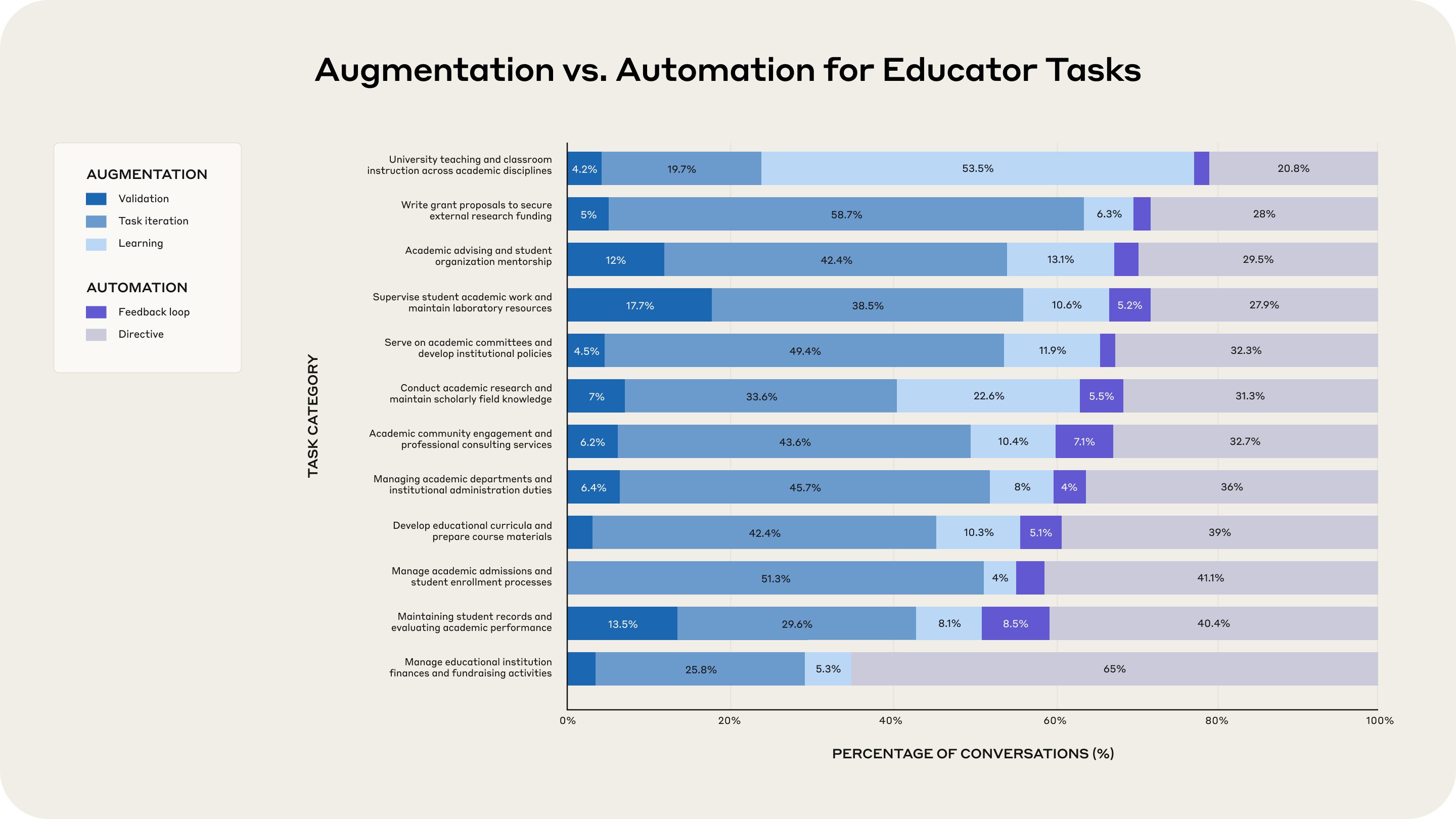Augmentation vs Automation in Education: What the Chart Reveals

Educators are not just experimenting with AI. They are quietly standardizing it across planning, research, and administration. A new dataset from Anthropic maps where faculty collaborate with AI and where they hand work off entirely. The short version. Teaching and advising are mostly augmented. Record keeping and finance lean toward automation. Grading shows a split that will keep ethics committees busy. anthropic.com
Augmentation dominates student facing work. Automation concentrates in back office tasks. Image adapted from Anthropic’s report.

Key takeaways that matter for policy and practice
Most faculty use AI to build curricula and materials
Curriculum development is the leading use case in Anthropic’s sample, followed by academic research and assessing performance. That matches what we see in the field. Faculty want help drafting lesson outlines, practice problems, and rubrics, while keeping control over the final output.
Teaching and mentoring are augmented, not replaced
Tasks that depend on context and judgment show a strong bias toward collaboration with AI. Lesson design, student advising, supervision of academic work, and grant writing all skew toward augmentation. This is where AI acts like a thinking partner rather than an auto pilot.
Administrative work skews to automation
Financial planning, fundraising, admissions, and record maintenance show higher rates of full delegation. That is where checklists and structured inputs allow safe templates and repeatable flows.
Grading is the flash point
Anthropic’s analysis flags that grading related conversations are less frequent overall, but when they occur a large share shows full delegation patterns. This is the risk area. Institutions need explicit guardrails before usage normalizes by default.
What the chart actually tells you
Augmentation wins in student facing work
University teaching and classroom instruction shows a large majority of augmentative patterns. Educators keep the loop closed and use AI to draft materials, generate examples, and iterate on explanations.
Automation clusters in repeatable processes
Managing finances, maintaining records, and handling admissions trend toward directive automation. These activities benefit from templates, validation rules, and audit trails.
The signal is consistent with Anthropic’s wider economic index
Across occupations, Anthropic has repeatedly measured a tilt toward augmentation over automation. Education mirrors that pattern but with sharper boundaries between front office and back office work.
Practical guardrails for schools and departments
Publish a clear grading policy
Define where AI can assist with feedback and where human evaluation is mandatory. Require instructors to disclose if AI contributed to rubric feedback. Spot check outcomes and keep a record of checks.
Separate student facing use from back office automation
Treat lesson design and mentoring as augmentation first. Treat admissions and finance as automation with approvals and logs. Build different controls for each lane.
Make provenance non negotiable
Store prompts, datasets, and generated artifacts with versioning. Keep a change log so reviewers can reconstruct decisions. Tie records to your retention policy.
Train for failure modes
Hallucinations, template drift, and silent policy violations are the real risks. Use validation steps, red team prompts for sensitive flows, and run shadow tests before scaling.
Measure what leaders care about
Time saved on preparation. Consistency of materials. Ticket resolution time in student support. Quality of feedback confirmed by sampling. Report these quarterly without time promises or delivery claims.
Methodology context you should know
Anthropic analyzed about seventy four thousand conversations associated with higher education email domains over a defined window. They mapped chats to educator tasks using the O*NET taxonomy and split interactions by augmentation versus automation. The authors note limits such as platform specificity, early adopter bias, and the challenge of inferring educator identity from chat data. Treat the findings as descriptive signals, not a census.
Bottom line
AI is already part of academic work. The pattern is clear. Augment the work that requires context and judgment. Automate the repeatable back office flows. Keep grading inside a governed loop with transparent records. Do this and you get real efficiency without crossing lines that damage trust.
